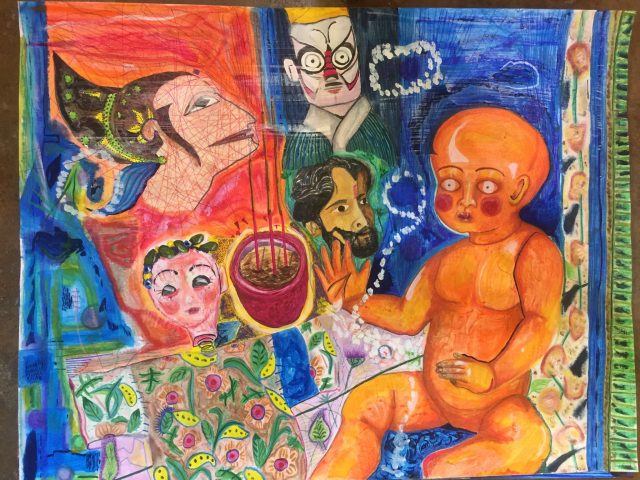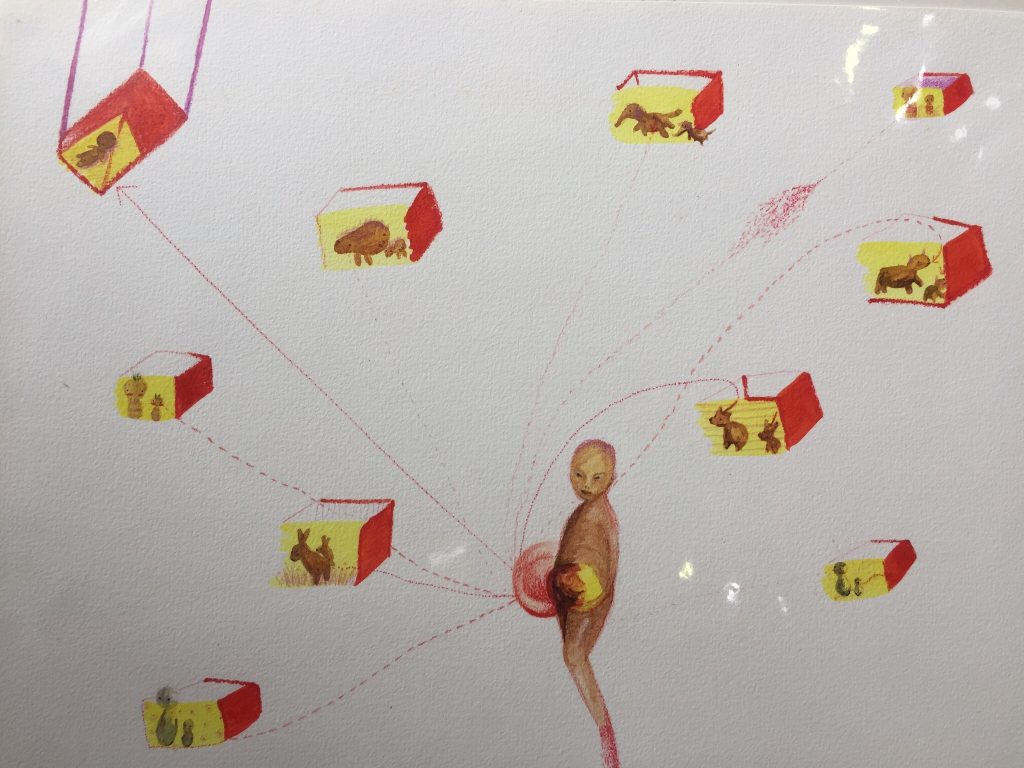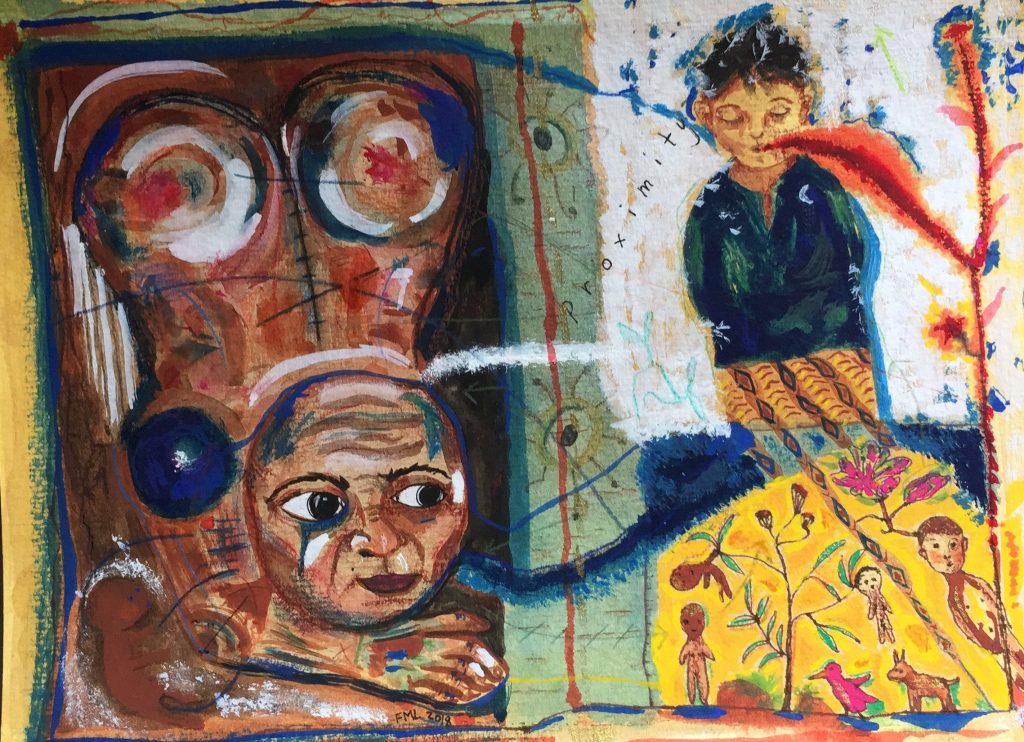having grown up using utensils she will never understand the comfort it brings: someone forming little mounds of rice that are pushed by the thumb into your mouth

October 24, 2019
Ta Pau // Bungkus: the bringing home of food prepared in a kopitiam or restaurant or cafe
The Ta Pau folio of the Transpacific Literary Project explores this cornerstone of Malaysian culture as a launching pad for honest conversations on national identity, race, religion, class, gender. Read here a conversation of vignettes with Carmen Nge, Joseph Gonzales, and Natasha Krishnan, then take yourself back to folio’s home, for more Ta Pau conversation.
Carmen Nge
It often seems like all Malaysians can ever talk about is food. I think we do this because food appears neutral, seemingly benign, and unlikely to offend—we congregate with those who share our love for laksa or nasi lemak or roti canai; we recount every detail of our favourite meals and immortalize food trends via Instagram.
And yet today the politics of food and what we eat is often shot through with moral judgment. I often read online of the environmental cost of eating meat, or the health repercussions of GMO foods. In Malaysia though, people rarely judge you for eating meat or for purchasing plastic wrapped food. Yes there are discussions about such issues, but in the end, you are still free to tuck into your mutton briyani and Malaysians still throng McDonalds, unperturbed by fears of the evils of fast food.
Occasionally, there are moments when food becomes overtly political: why was beef rendang served in an event where Indians were present? Why was roast pork on display in locations where many Malays are present? Why should the name “hot dog” be changed just because religious authorities are worried Muslims will think dogs are used to make the sausages?
But such incidents die down as quickly as they flare up. Malaysians generally don’t pay much attention to such incidents because they know, in the end, the culture of eating will triumph.
Joseph Gonzales
Being away from Malaysia since 2016, and Mum passing away in 2012, food has become a even bigger trigger for memories. Allow me to share about my mum, Victoria Gonzales who was born in 1917, and was married off to her uncle (husband of her aunt who passed away leaving three children barely younger than herself). I think she was a vivacious girl who lost her two siblings to disease when they were children, then had to become a woman really fast. Much transpired between then, and when I was born to her in 1960. She was 43 and I was her 7th child. She was literate only in Malayalam, and it had a fierce belief in God that kept her so strong through the World War and the Japanese Occupation. I remember her talking about having cows, and growing tapioca. She was not a touchy-feely person and I never recall her saying that she loved any of us siblings, and certainly not me, as I was growing up. But she slaved over the stove from the early hours of the morning—there was always food for us, and food for anyone who came. All this on one man’s salary! How did they do this?
Food was the way she showed her love. What I remember to this day are her speciality dishes of fish curry with ladies fingers, tomatoes and Malayalee vegetable dishes like ‘aviyal’. Her breakfast puttus with fish curry, coconut or banana and her tapioca wedges slapped with tumeric are my favourites. Beyond my family circle, I have many Malaysian friends and family that warmly open their doors during festive seasons or even on a daily or weekly basis. This is love.
One household in particular has a green table in the dining room and lunches go on for hours—with conversation from the sublime to the ridiculous. Interestingly, “The Green Table” is an iconic work in contemporary dance by Kurt Jooss—a political work that was a response to the rise of Nazi power, invasion, and World War.
Natasha Krishnan
Joseph, I love that we can all associate this love of food with family, home, warmth, as well as comfort. My atteh and I still have this “ritual” of sorts that we engage in, where even now, in this day and age, she gives me the same sense of comfort when she feeds me with her hands.
It’s not a practice unheard of as well. We were all fed that way as children! My friends would often lament about their losses growing up, and that would include a hand-fed meal from amma or paati, with lovingly concocted curries and just the right amount of pickles. It all begins with some scoops of rice, depending on how many will be sharing from that plate: she usually mixes enough for me and my sister, and she’ll occasionally take bites from the same plate too. Then, the curries; my favourite is usually paati’s chicken curry with badham instead of santan, or atteh’s chicken sambal, spicy enough to make your tongue sting for awhile. Then the veggies go into the concoction of mixed rice. The most dangerous part is the eating: you will have no control over how much you eat! Atteh always manages to cajole me into eating everything, down to the last mouthful of rice. “It’s the last mouthful only right? Eat lah. Just eat.” I acquiesce.
While this makes me feel nice and fuzzy, I do sometimes get the occasional “Ohmaigawd why are you eating liddat?!” or “Eeeee I geli la, you okay meh?” from onlookers of non-Indian or non-Malay origin. Usually the Chinese, but what can I do? There was also the occasional remark from my mother in Cantonese: “ngoh jip sau mm dou”. I just can’t accept it (so I won’t eat it that way) I’ll just shrug it off. My mother being Chinese and having grown up using utensils will never understand the comfort it brings: someone going through all the trouble of shelling shrimp, de-boning fish or chicken, then forming little mounds of rice to push by the thumb into an eager mouth. I’ll not give this up, ever! And I’m happy she still does it for me whenever I visit. To the outsider, this is considered odd, disgusting, even primitive, but let me ask you this: How did we eat food before the invention of utensils?
Carmen Nge
Thanks Natasha! I like this and wish I had someone to hand feed me when I was a kid! My mom is Chinese so I can relate about hand feeding as being not commonly done, or done at all, in Chinese communities. It might also have something to do with the kind of food commonly eaten in Chinese households: hot soups, soupy noodles, boneless bite-sized strips of meat and fish—food that either necessitated utensils or food that was already designed to be eaten with them. I cannot remember a single meal that did not involve hot soup of some kind or other—usually medicinal or herbal in nature and sometimes tasting terribly bitter or strange.
As such, my brother and I always ate with Western cutlery (forks and spoons), or chopsticks (once we learnt how to handle them deftly) because my mom was also obsessive about clean hands. She has been a hospital nurse her whole life so I can understand her OCD nature when it came to hygiene and constant cleaning. So eating with hands was a no-no.
Nonetheless she was a great cook, when she had the time to do so in between working in shifts as a nurse. When she worked the night shift, we hardly saw her at all and had to be content eating food from a tiffin carrier, supplied by some enterprising aunty running a very practical food business for working moms. Dad, of course, did no cooking and hardly even stepped in the kitchen, save to do the washing up after meals or to boil some water in the morning for our breakfast beverages. Frankly, I don’t think he can even cook and we never thought to dare him to try either!
When mum did not have to work on the occasional weekend, she would bake the most delicious cakes and cookies—my favourite was her light-as-air pandan chiffon cake, wonderfully infused with the aroma of pandan grown in our garden. She always believed that hand-whisking the egg whites is the best way to ensure they form perfectly stiff peaks to ensure maximum standing power when the chiffon cakes emerged from their O-shaped tins. Of course, it was mostly left to me to do the hand-whisking. If you want to eat it, then you jolly well whisk it, she used to chide me when we begged her to bake our favourite cake. My brother was too young to really put his elbow into the whisking process so it was always me, sitting cross legged on the bare, concrete kitchen floor, with a huge ceramic bowl full of egg whites balanced between my knees and my arms aching from what seemed like hours of non-stop whisking.
Her baked goods were legendary, especially during Christmas parties where my parents would host their annual open house and at least 50-70 people would visit us at various points on Christmas Day to sample mom’s home-cooked Asian style roast turkey and her trays of delectable pastries, cakes and sweets. I always remember friends of all ethnic groups feasting together—Muslim and non-Muslim—and no-one asked about whether something was halal or not.
No pork was served for our Muslim friends and that was halal enough for them. No-one enquired as to whether the turkey was slaughtered following Muslim rites but everyone happily ate from the same large turkey plate. I only remembered being told by my parents not to serve our Muslim visitors Shandy because that was deemed not halal. So I always grew up thinking Shandy would make you drunk although as a kid, I used to marvel at how I never suffered from that predicament even after quaffing a few cans on the sly.
In the last decade, however, the number of our Muslim visitors have dwindled and those who do come for the annual Christmas party often decline the lunch and only snack on peanuts or cookies. We also stopped mixing drinks for guests and instead, just buy packet drinks—this is partly to save the hassle of washing cups and glasses many times throughout the course of a day’s party, but also to ensure that people do not feel obligated to drink from glassware used to serve non-halal beverages.
How the times have changed and how far we’ve travelled from the spirit of shared meals.



